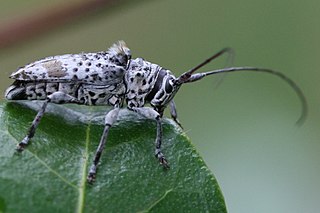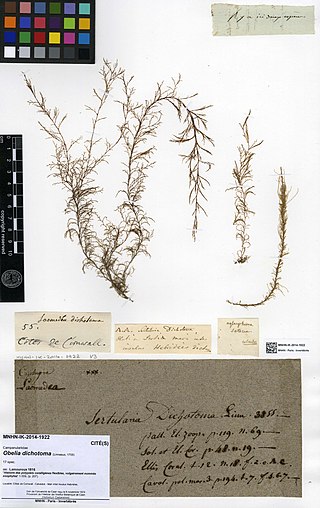
Dynastinae or rhinoceros beetles are a subfamily of the scarab beetle family (Scarabaeidae). Other common names – some for particular groups of rhinoceros beetles – include Hercules beetles, unicorn beetles or horn beetles. Over 1,500 species and 225 genera of rhinoceros beetles are known.

Allomyrina dichotoma, also known as the Japanese rhinoceros beetle or Japanese horned beetle, is a species of rhinoceros beetle. They are commonly found in continental Asia in countries such as China, the Korean peninsula, Japan, and Taiwan. In these areas, this species of beetle is often found in broad-leaved forests with tropical or sub-tropical climates. This beetle is well known for the prominent cephalic horn found on males. Male Japanese rhinoceros beetles will use this horn to fight other males for territory and access to female mating partners. Upon contact, males will attempt to flip each other onto their backs or off of their feeding tree. In response to selective pressures, smaller male A. dichotoma have adapted a "sneak-like behavior". These smaller beetles will attempt to avoid physical confrontation with larger males and try to mate with females.
In Greek mythology, Demonassa or Demonassae was a name attributed to five women.

Utricularia dichotoma, commonly known as fairy aprons, is a variable, perennial species of terrestrial bladderwort. It is a widespread species with mauve or purple fan-shaped flowers on a slender stalk and usually grows in wet locations.

Millepora dichotoma, the net fire coral, is a species of hydrozoan, consisting of a colony of polyps with a calcareous skeleton.

Callicarpa dichotoma, the purple beautyberry or early amethyst, is a species of beautyberry. They are cultivated as garden shrubs. The flowers are pink to white. The berries which are small drupes are purple. The fruits grow closely together in large clusters. The fruit provides food for wild life. The berries are edible and have a mild taste. This species can be found in China, Vietnam, Korea and Japan.

Pimelea flava is a species of flowering plant in the family Thymelaeaceae and is endemic to south-eastern Australia. It is a shrub with narrowly elliptic to egg-shaped leaves arranged in opposite pairs, and compact clusters of 9 or more flowers with 2 or 4 elliptic to circular involucral bracts at the base. The flowers and bracts are white or yellow, depending on subspecies.
Irus or IRUS may refer to:

Cordia dichotoma is a species of flowering tree in the borage family, Boraginaceae, that is native to the Indomalayan realm, northern Australia, and western Melanesia.

Silene dichotoma is a species of flowering plant in the family Caryophyllaceae known by the common name forked catchfly. It is native to Eurasia and it is known in other parts of the temperate world, such as sections of North America, where it is a weed that grows in disturbed habitat. It is an annual herb growing up to 80 centimeters tall. The lance-shaped leaves are up to 8 centimeters long on the lower stem and are smaller farther up. Each flower is encapsulated in an inflated calyx of sepals lined with ten veins. It is open at the tip, revealing five white to red petals, each with two lobes at the tip and sometimes taking a curled form.
In Greek mythology, Tisamenus was a king of Thebes, son of Thersander and Demonassa, the daughter of Amphiaraus. When Thersander died on Mysia in the Trojan War, Peneleos acted as regent for Tisamenus until he came of age. Little is known about his rule. He was succeeded by his son Autesion.

Zygocerini is a tribe of longhorn beetles of the subfamily Lamiinae. It was described by Lacordaire in 1872.

Tabernaemontana dichotoma, commonly known as Eve's apple, is a plant in the dogbane family Apocynaceae. The specific epithet refers to the species' dichotomous branches.
Demonassa is a genus of longhorn beetles of the subfamily Lamiinae.

Fimbristylis dichotoma, commonly known as forked fimbry or eight day grass, is a sedge of the family Cyperaceae that is native to tropical areas.

Iris dichotoma is a species in the genus Iris and is also in the subgenus of Iris. It was once formerly known as Pardanthopsis dichotoma as it was placed in a genus of its own before DNA testing resulted in it returning to the genus Iris. It is native to the forests and grasslands of Siberia, China, Mongolia and Korea. It has long greyish green leaves, long branched stems carrying many flowers in summer or late summer. In shades of violet, mauve to purple, lavender, pale blue, white or pink. They appear in the late afternoon at the time of Vespers.
Demonassa marmorata is a species of beetle in the family Cerambycidae. It was described by Stephan von Breuning in 1939. It is known from Australia.
Aristida dichotoma, known as churchmouse threeawn, fork-tip three-awn, pigbutt three-awn, and poverty grass, is a species of grass from eastern North America. It is native to the Eastern and Midwestern United States and Ontario, Canada. It has been introduced in California. It was described in 1803 by André Michaux.

Obelia dichotoma is a broadly distributed, mainly marine but sometimes freshwater, colonial hydrozoan in the order Leptothecata that forms regular branching stems and a distinctive hydrotheca. O. dichotoma can be found in climates from the arctic to the tropics in protected waters such as marches and creeks but not near open coasts like beaches in depths up to 250m. O. dichotoma uses asexual and sexual reproduction and feeds on mainly zooplankton and fecal pellets. Obelia dichotoma has a complex relationship with the ecosystem and many economic systems.

Dictyota dichotoma is a species of Brown algae found in the temperate western and eastern Atlantic Ocean, the Mediterranean Sea, the Black Sea, the Red Sea and the western Indian Ocean.













